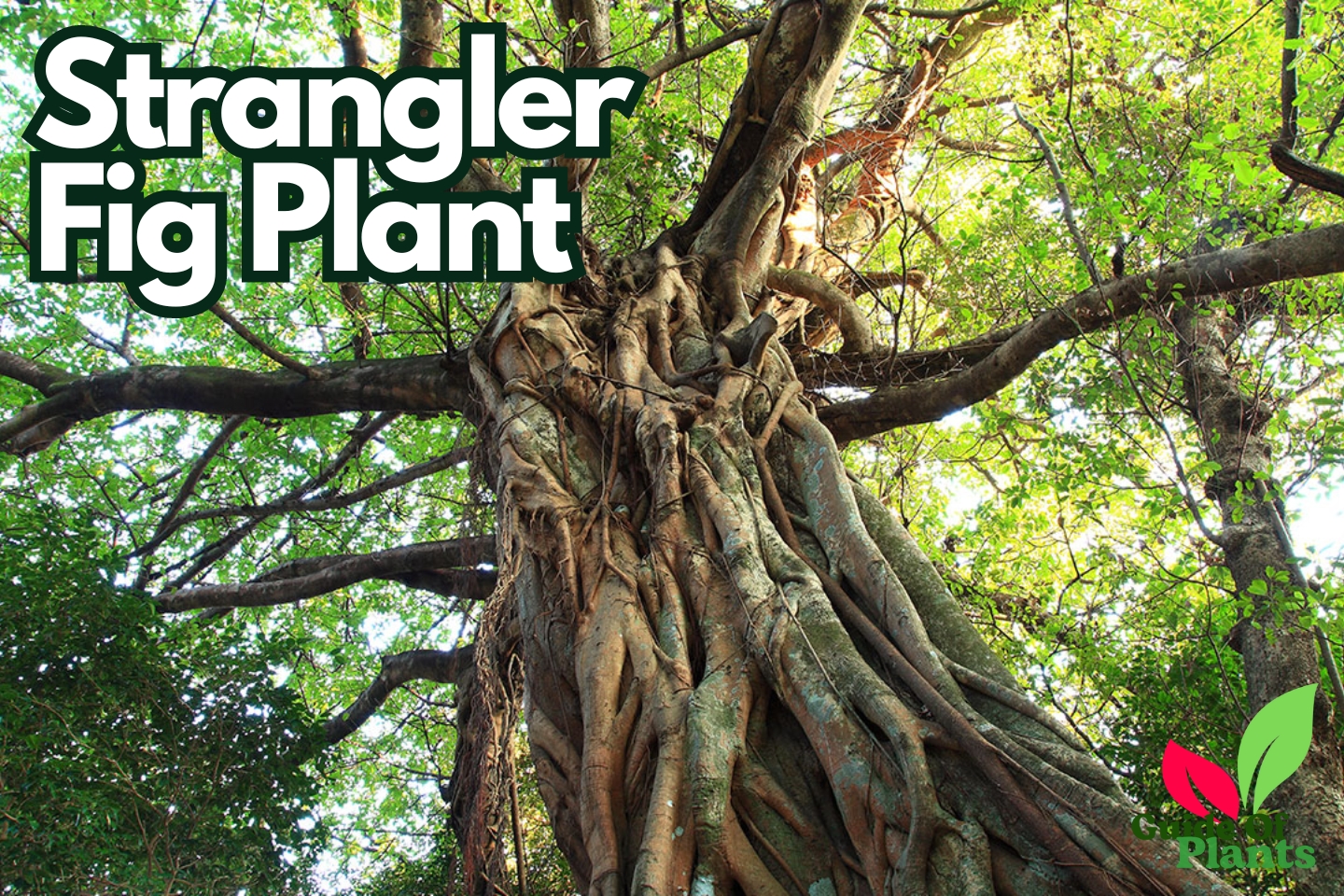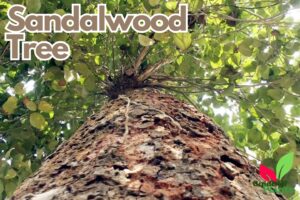Strangler fig plants are a unique group of plants with a fascinating life cycle and growth habit adapted to tropical forest environments. Known for growing on other trees and enveloping them over time, strangler figs showcase the creative power of evolution.
With aerial roots that descend to the forest floor and an enclosure strategy allowing them to outcompete host trees, strangler fig plants biology enables their survival in tropical forests. Their life cycle also relies on specific insect pollinators, demonstrating coevolution.
Table of Contents
Scientific Description Of Strangler Fig Plant
Here is a detailed scientific description of strangler fig plants, including various aspects of their unusual biology and ecology:
Taxonomy and Physical Characteristics
Strangler fig plants belong to the large, predominantly hemi epiphyte genus Ficus family (Moraceae) comprising around 800 species of woody trees, shrubs and vines distinguished by unique enclosed inflorescences termed syconia. Strangler fig species occur throughout diverse tropical and subtropical forest habitats, but exhibit key ecological and morphological similarities. Physically, most display thick green stems with semi-smooth gray bark texture and an often extensive network of descending aerial roots. Large, vibrantly colored syconia emerge directly from branch axes at maturity, exhibiting diverse shapes from globose to elongate-pyriform. Thick green leaves vary from small and rounded to large and oblong.
Also Know About: Discover The 3 Main Types of Forest Trees You Must Know
Reproductive Biology and Life Cycle
The unusual life cycle and reproductive strategies of strangler figs promote survival in tropical canopy conditions. Typically, minute, seed-bearing strangler fig plant syconia are first consumed and actively dispersed by host-specific fig wasps. Voyaging vertebrates like fruit bats and birds may also ingest syconia, passively transporting seeds to new germination locales. However dispersed, seeds deposited upon suitable lofty canopy perches soon sprout. Established juvenile individuals then exhibit remarkably rapid early root elongation heading down host tree trunks.
This facilitates access to soil moisture and nutrients required for vigorous growth. Aerial roots gradually enlarge and fuse laterally around host trunks as they elongate, slowly forming sturdy, meshed scaffolds. Gradually they squeeze underlying bark, restricting light, moisture and space availability in a strangling process which proceeds over months to years depending on the strangler fig species. Eventually most overwhelm and kill host trees, leaving towering hollow root columns and expansive, leafy canopies benefitting associated organisms.
Ecological Importance
Beyond fascinating reproductive strategies, strangler figs provide critical resources sustaining tropical forest ecosystems. Their ample crops of large, tasty syconia feed diverse frugivorous animals from fruit bats to monkeys across seasons when other fruits grow scarce. Cavities in mature root balls furnish shelters or nest sites for various vertebrates and invertebrates too.
Epiphytes and lianas also establish upon the suspended soils building up around strangler fig root structures high in canopies. And once aging individuals collapse completely they enrich forest floor mound microhabitats, facilitating plant and animal recruitment. Overall strangler figs exemplify a specialized hemi epiphyte strategy allowing them to efficiently exploit forest gaps and exert lasting impacts on tropical forest architecture and community dynamics through intricate ecological interactions over their long lifespans.

Aerial Roots Allow Access to the Forest Floor
- Unlike most plants, strangler figs initially germinate high in the forest canopy. They send aerial roots down the trunks of host trees, eventually accessing soil nutrients. The roots grow rapidly, facilitating quick establishment.
- Leaves Display Adaptations to Low Light Once their roots reach the shaded understory, strangler fig leaves must function despite limited sunlight. Adaptations like variation in leaf size and shape maximize light capture.
- Strangler figs depend on interactions with particular fig wasp species for pollination and seed dispersal. This coevolutionary relationship perpetuates their mutual survival.
- As strangler fig aerial roots thicken over time, they gradually envelop the host tree in a mesh-like structure that competes for space, air, sunlight and soil moisture. This “strangling” capacity gives them their name.
Unique Ecosystem Roles of Strangler Fig Plants
- With relationships spanning from tropical understory to canopy, strangler figs fill an indispensable niche in forest ecosystems. Their fruits support diverse wildlife too.
- Nesting Sites and Food Sources for Animals The hollow interiors remaining once strangler figs outcompete their hosts provide shelter for various animals. Figs also serve as a critical food for tropical wildlife.
- Lianas, epiphytes and even new generations of strangler figs often establish on older strangler fig structures. Their ascending stems and suspended soils are important germination sites.
Also Know About: Brassica Rapa
How Strangler Fig Plants Grow
The beginning stages of Strangler fig plants start life in the rainforest canopy, often transported as seeds by birds or bats to the branches of a host tree. Their unusual early root growth allows them to thrive.
Seeds Carried by Animals to Host Trees Specific species of bats and birds ingest the fruits of strangler fig plants, later depositing the seeds in their droppings. This dispersed placement sets the stage for germination upon host trees.

Early Root Growth Towards Forest Floor Nutrients
Once germinated, strangler fig seedlings immediately send aerial roots racing down towards the soil below for access to moisture and nutrients unavailable in the canopy. Vertical growth proceeds rapidly.
Expanding Leaf Cover and Root Structure As part of establishing itself, a young strangler fig quickly extends leafy branches laterally while its descending aerial roots continue to lengthen and swell in diameter.
Horizontal Branch and Leaf Expansion
To capture limited light, strangler figs grow outward with many clustered stems and leaves. Greater leaf surface area increases photosynthesis potential during this vulnerable stage. Downward Root Growth Encompassing Host Tree The aerial roots emerging from strangler fig stems gradually encase sections of the host tree’s trunk as they elongate towards moisture and soil nutrients below. More roots emerge to expand the scaffolding.
Mature Strangler Fig Structure and Form
Given time and ideal conditions, descended strangler fig aerial roots spread laterally and connect, completely enveloping the host in a meshed, free-standing structure open at the top. Fused Root Structure Replaces Host Trunk Eventually aerial roots fuse laterally, replacing the host tree trunk with a sturdy, hollow support composed entirely of strangler fig tissue. Enclosure is typically gradual but unrelenting.
Emergent Canopy Supported by Root Scaffolding
As the host tree is edged out, the extensive aerial root network of the now mature strangler fig forms a tall, hollow column anchored in the soil. An expansive leafy canopy emerges from the apex, completing the distinctive structure.
Also Know About: Chervil or Chervil Herb
The Strangling Process Over Time
The steady vertical and lateral expansion of strangler fig aerial roots progressively restricts the host tree’s access to sunlight, moisture and soil nutrients. Still, the gradual shift favors fig dominance. As strangler figs grow over months and years, their increasing network of aerial roots slowly envelops more and more of the host tree’s bark surface, eventually creating a sturdy, meshed structure surrounding the host.

This latticed root cage cuts off exposure to sunlight and rainfall, while also occupying more and more space and access to soil moisture and nutrients. Though relentless, the strangling process generally proceeds slowly, allowing the strangler fig ample time to establish an extensive root and branch framework to support itself independently as the weakened host tree goes into decline.
- Reduction of Light and Water Availability: Expanding root and stem growth allows strangler figs to block increasing proportions of incoming sunlight and rainfall from reaching enclosed host tree surfaces. With less energy production and moisture supply, host trees weaken gradually.
- Usurping Soil Resources and Space: As they elongate down through the canopy, strangler fig aerial roots extract water and soil nutrients before host tree roots can access them. Over time, the fig roots dominate subterranean space, spreading extensively and depriving hosts through underground competition.
Outright Displacement of Infirm Host Trees
Inevitably the spreading foliage and ever-thickening root mantle of established strangler figs kills enveloped host trees by shutting off all outside resources. This allows complete fig dominance.
Strangler figs are well equipped to capitalize as hosts decline, having thoroughly integrated into surrounding space with numerous robust stems and roots. As enclosed host trees grow increasingly feeble and infirm from light, water and nutrient deprivation, strangler figs adapt their vacated positions. Expanding exponentially, the fig sends vigorous new growth up through hollow root columns and out tips of stems exposed at the canopy exterior.
Threats Facing Strangler Fig Plants
As tropical rainforest specialists, strangler figs suffer declines when human activities degrade, divide or destroy their fragile forest ecosystems. Their unusual life cycles also increase vulnerability.
Strangler figs rely on intricate relationships and narrow habitat requirements, making them especially prone to population decreases amid deforestation. Removing host trees eliminates strangler fig germination sites. Fragmenting tropical forests also isolates fig wasp pollinators and fruit-dispersing animals. Without these key mutualists transporting pollen and seeds between stranded plants, regeneration falters. And edge-effects like reduced humidity and increased wind disrupt strangler fig communities now bordering degraded zones.
Loss of Keystone Host Trees
Mature strangler figs depend initially on vulnerable canopy trees for early development. Eliminating tall, emergent giants thus threatens the next strangler fig generation. These key future host trees require very specific, stable rainforest conditions.
Disruption of Animal and Insect Partnerships
Defaunation of wildlife through over-hunting further reduces strangler fig reproduction by lowering fig wasp, bat and bird numbers. These key mutualists move pollen and seed between isolated plants. Protecting these mobile links is essential.
Also Know About: Ficus Bonsai
Susceptibility to Changing Environmental Conditions
Strangler figs also face threats from climate change and spreading diseases which can disrupt finely-tuned ecological relationships in unpredictable ways. Tracking these impacts is challenging.
As climate variability increases with global warming, once stable tropical rainforest environments may change too rapidly for specialization. And worsening storms and fires negatively impact strangler figs. Tracking precise responses is complicated by their longevity and complexities. Emergent diseases affecting key species like fig wasps also have cascading, cryptic effects across strangler fig communities. Again though, delineating detailed consequences is difficult.
Unique Characteristics of Strangler Fig Plants
The distinctive biology and growth habits of strangler figs facilitate survival in challenging rainforest environments. Their innovations allow exceptional tropical forest control. Strangler figs genuinely showcase the endless forms evolution can sculpt through natural selection. Starting life high in forest canopies, they germinate upon precarious perches, often the branches of emergent giants. Yet despite these uncertain beginnings, strangler figs thrive.
Rapid vertical root extension grants them early access to moist rich soils below, sustaining those pioneering individuals sprouting successfully if temporarily in the bright canopy. And supportive root buttressing grants lasting stability. It also facilitates overtopping and eventual elimination of original host trees, allowing strangler figs to efficiently exploit forest gaps. Such aggressive enclosure secures the light and space needed for continued dominance. And large, tempting fruit crops reliably attract hungry animals. These animals then disperse strangler seeds widely, propagating the next competitive generation.
Rapid Vertical Root Descension for Stability Quickly extending numerous aerial roots down existing trunks grants strangler figs critical early support while also providing access to soil moisture and nutrients needed for growth. This facilitates host tree overtopping.
Lateral Enclosure for Space Acquisition
The meshed, interlinked root mantle strangler figs gradually wrap around host trees, allowing them to physically claim increasingly more space and resources. Hollow aerial root columns then structurally replace declining host trunks.
Also Know About: Malabar Spinach
Key Ecosystem Roles Across Forest Strata
From forest floor to canopy, maturing strangler fig plants support other organisms. Their fruits sustain abundant wildlife populations while their structures foster complex ecological community assembly. Strangler figs essentially act as vertical reefs within tropical forests. Their descending draperies of coiled roots cradle soils, moisture and debris in suspended platforms from understory to canopy. Diverse plant assemblages can then be established directly upon strangler fig scaffolds. And cavities remaining inside hollowed root remnants furnish nest sites or hiding spots for various vertebrates and invertebrates. Even canopy gaps created by fallen older strangler figs enable additional plant recruitment. Replacement strangler figs may sprout within these openings too, continuing the cycle.
Strangler Fig Plants Showcase Nature’s Creative Complexity
Strangler fig plants exemplify the intricate interdependencies and unpredictable creativity underlying rainforest ecology through their unique life cycles and relationships. Their existence relies upon serendipitous seed dispersal by fig wasps and animals to vulnerable canopy perches where conditions just might enable growth. Then commensal root scaffolding descends, outpacing neighbors towards fertile soils below.
Patient rounding and eventual throttling of host trees proceeds over years as strangler figs enact ecological domination. Yet despite such selfishness, they support abundant diversity too. Figs feed countless fruit-eating vertebrates while their suspended root balls furnishing niches for ants, beetles, spiders and vertebrates alike. Showy emerald lianas cascade down aging columns in vibrant displays. And when crowns finally crash down, more light and space become available, propagating ecological novelty.
Intricate Links Across Forest Strata and Species
From frugivorous bats dispersing seeds to lizards inhabiting hollowed root balls, strangler figs depend upon and foster diverse rainforest life across vertical forest layers. They exemplify ecological interconnectivity.
Powerful Illustrations of Evolutionary Invention
The distinctive adaptive strategies and integrated relationships strangler figs maintain highlight the creative potential of natural selection and coevolution over eons. Myriad intricate innovations sculpt their unlikely yet enduring ecological success.
Also Know About: Miyazaki Mango Plant

Conclusion
Ultimately, the peculiar strangler fig plant represents a natural wonder deserving appreciation. Through unique biology and diverse ecological connections, strangler figs showcase the marvels evolution cultivates over time. They reveal the intricate links binding individual species into broader rainforest communities, highlighting vulnerability. As human activities continue fragmenting tropical forests worldwide, understanding our impacts matters more. Because like so many organisms, strangler figs cannot persist alone. Their perpetuation relies intrinsically upon habitat integrity and partners from bats dispersing seeds to lizards fertilizing fig flowers. Protecting these interconnected relationships and the vibrant forests sustaining them remains essential for conservation moving forward. Doing so ensures the continued wonder strangler figs impart can endure for generations to come.
We owe tropical ecosystems like those strangler fig plants shape respect and cared stewardship. Through mindful coexistence we benefit too, gaining precious inspiration from their creative complexity. Each aerial root descending, each fig consumed and seed spread reflects enduring hope. And appreciating the unfamiliar magic strangler fig plants exemplifies offers perspective during difficult times. If given the opportunity, life always finds a way through challenges towards the light again. From forest floor to canopy, strangler figs showcase nature’s resilience through the creativity, complexity and growth binding all living things together.
What are strangler fig plants?
Strangler fig plants are a unique group of tropical plants with an unusual lifecycle. They begin life as seeds dispersed high up in rainforest canopies. If fortunate enough to land on suitable host tree branches, they germinate and send rapid growing aerial roots down the trunk. Gradually these descending roots surround and mesh together around the host tree’s bark, eventually squeezing its trunk and cutting off light, moisture and nutrients in a “strangling” process that can last years. Over time, the mesh of strangler fig roots completely envelops the host tree and may kill it.
By then though, the strangler fig has stabilized on a tall hollow root column and sends up fresh branches and leaves towards the light from this new supportive scaffolding. Strangler fig plants rely intrinsically on their rainforest habitats and coevolved animal partners for reproduction and growth. Their fascinating adaptive biology allows them to efficiently exploit forest gaps. Unique ecological attributes also make them important keystone species supporting abundant life across vertical forest layers while shaping typical tropical forest form.
How do strangler fig seeds spread?
Strangler fig plants depend on specific species of fig wasps and various fruit-eating vertebrates like birds and bats for pollination and seed dispersal. These animals ingest the mature fig fruits and later deposit strangler fig seeds to new host trees via their droppings. This interdependent co-evolutionary relationship allows strangler figs to efficiently propagate successive generations.
Various bats, birds, monkeys and other vertebrates consume the ripe fruits. As seed dispersers, these animals facilitate new strangler fig development in tropical canopy gaps. Continued seed spread helps maintain genetic diversity.
Why are strangler figs important ecologically?
Beyond their fascinating biology, strangler fig plants serve critical ecological roles across rainforest layers. Their fallen fruits sustain diverse fruit-eating animals while maturing root structures furnish shelters, nest sites and hiding spots for various vertebrates and invertebrates. Suspended root platforms support epiphyte, fern and liana establishment too.
Older strangler figs falling create light gaps, facilitating forest renewal. Younger strangler figs even sprout upon such enriched mounds of debris. So from food web support to forest architectural contributions, strangler figs maintain tight ecological links benefitting tropical biodiversity.
How do strangler figs affect tropical forests?
As strangler fig root scaffolds grow, they substantially alter tropical forest structure. Descending aerial roots transport moisture, nutrients and soil between layers, enriching canopies. Broad fig tree crowns also produce significant shade below.
Fallen aged strangler figs leave enriched mounds fostering plant and animal recruitment. Such lasting impacts physically shape rainforest habitats. Additionally, the coevolved animals strangler fig plants rely upon for reproduction influence forest composition through directed seed dispersal patterns over generations.




